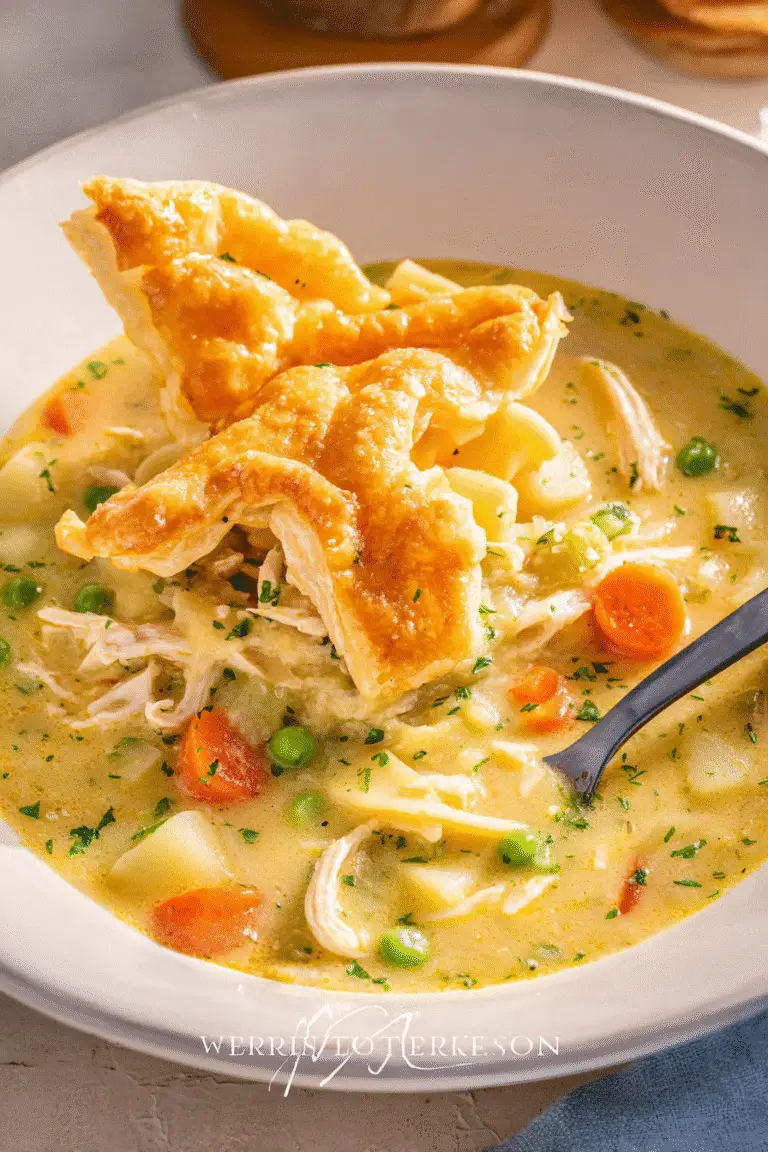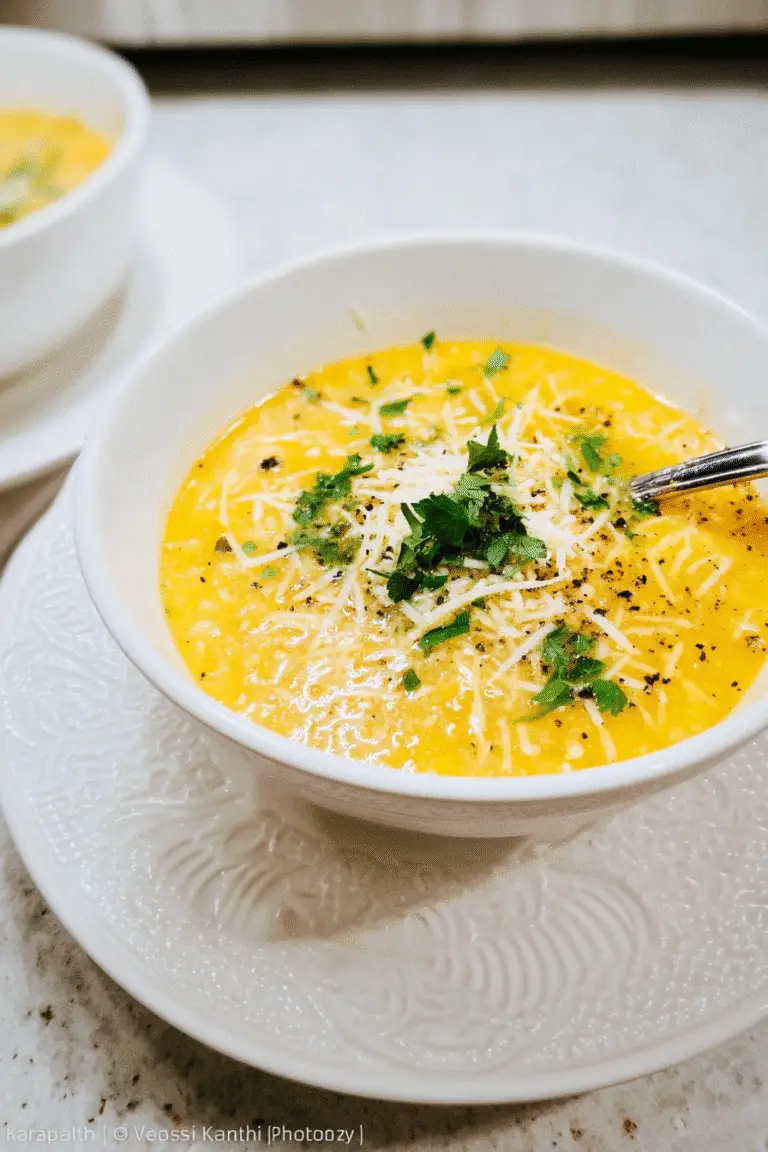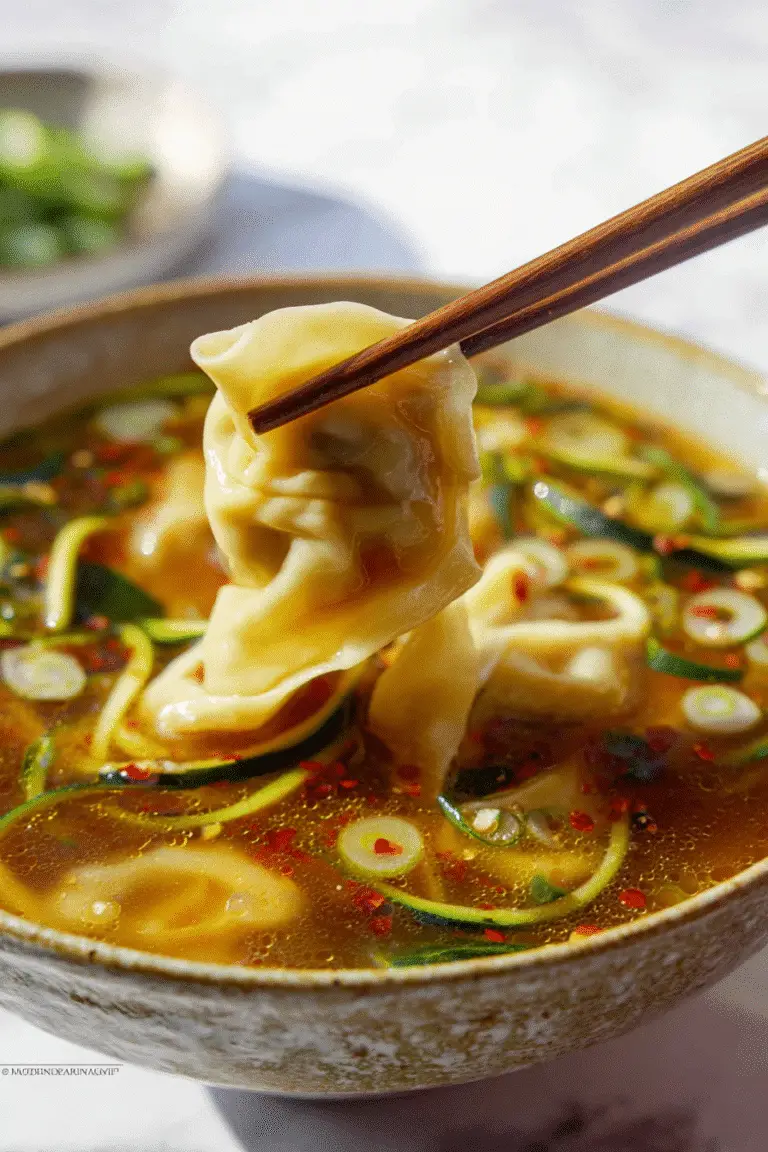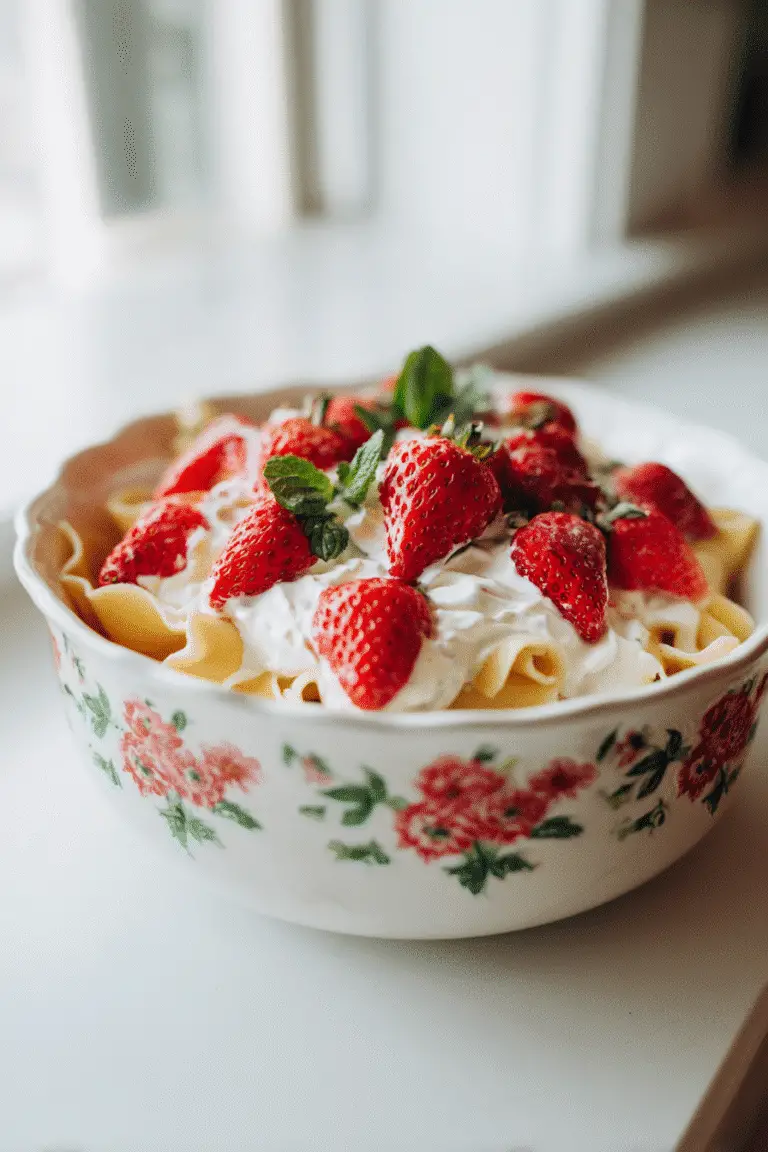Sicilian Sardine Pasta
Sicilian Sardine Pasta: A Flavorful Mediterranean Legacy You Must Try
A Sicilian Memory That Changed My Table Forever
Sicilian Sardine Pasta brought me back to a dusty kitchen in Palermo, years ago. I was only a teen, traveling with my aunt who had roots deep in Sicily.
She handed me a plate of this golden, fragrant pasta topped with crispy breadcrumbs, and I was hooked. That one bite—savory sardines, soft raisins, the crunch of pine nuts—was like a story told through flavor. Ever since then, I’ve been chasing that moment in my own kitchen. And today, I want to share it with you—not just the recipe, but the experience.
If you’re craving something soulful, healthy, and stunningly simple to make, this one’s for you.
Understanding the Heart of Sicilian Sardine Pasta
What Makes Sicilian Sardine Pasta Truly Sicilian?
Sicilian Sardine Pasta, known as Pasta con le Sarde, is more than just a dish—it’s a cultural icon. This traditional meal from Sicily dates back centuries and combines humble, fresh ingredients like sardines, wild fennel, saffron, pine nuts, and raisins into a fusion that reflects Sicily’s complex history of Arab, Spanish, and Italian influences.
It’s sweet, salty, earthy, and aromatic all in one bite.
- Wild fennel brings herbal brightness
- Anchovies deepen the umami punch
- Golden raisins add a touch of sweetness
- Sardines (fresh or canned) are the bold heart of the recipe
Traditional Origins: A Recipe Rooted in History
Legend says it was invented by Arab cooks during their conquest of Sicily in the 9th century. They paired local pasta with Mediterranean ingredients, creating a dish with unique balance—sweet from raisins, savory from sardines, aromatic from fennel and saffron.
Fun fact: It was originally served as a street food by fishermen who used what was available after their daily catch.
Print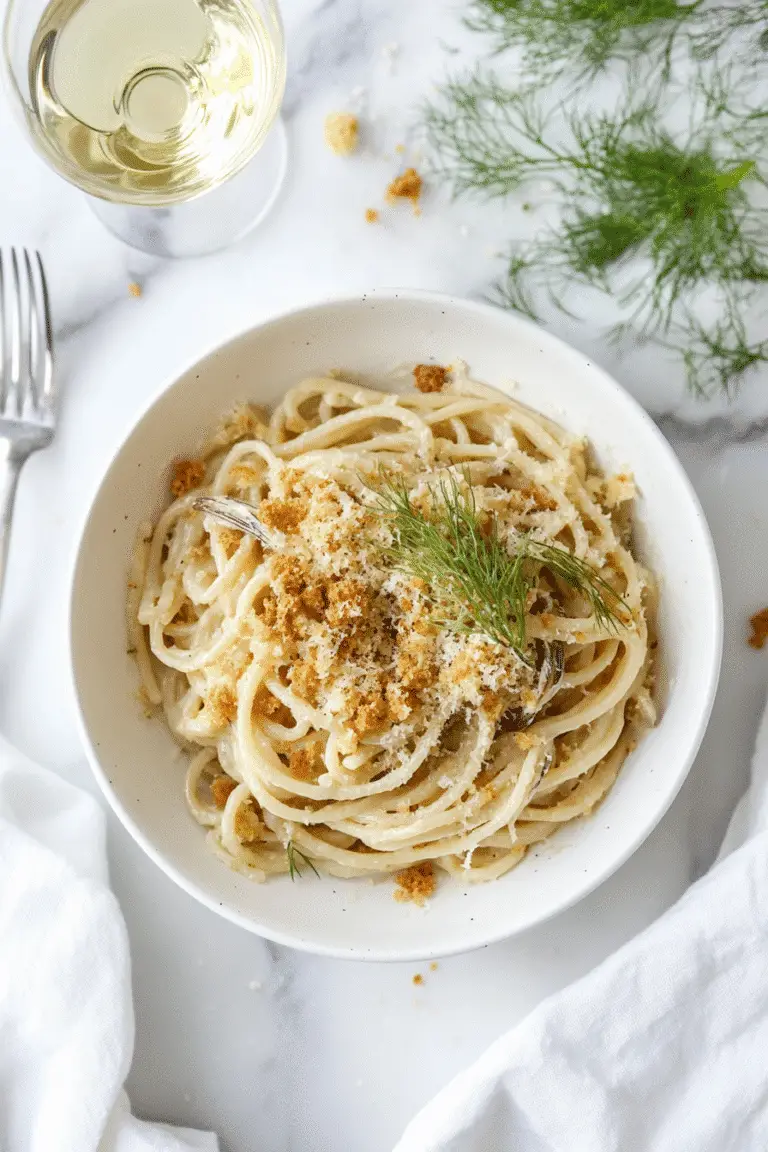
Sicilian Sardine Pasta
This Sicilian Sardine Pasta (Pasta con le Sarde) blends savory sardines, aromatic fennel, sweet raisins, saffron, and crispy muddica (toasted breadcrumbs) into a traditional Mediterranean dish that’s rich in flavor and easy to make at home.
- Total Time: 45 minutes
- Yield: 4 servings
Ingredients
500g (1.1 lbs) bucatini or spaghetti pasta
100g (3.5 oz) fresh sardines, cleaned and cut into pieces (or canned sardines in olive oil)
¼ cup pine nuts
1 cup fresh breadcrumbs (from day-old rustic bread)
¼ cup golden raisins or sultanas
1 envelope (0.1g) saffron
1 fennel bulb with fronds (or large handful wild fennel)
1 large onion, diced
3–4 oil-packed anchovy fillets
5 tbsp olive oil, divided
Salt and black pepper, to taste
¼ cup hot water (for saffron and raisins)
Instructions
If using fresh sardines, clean them by removing the head, tail, and backbone. Rinse well, pat dry, and cut into 3–4 pieces. Set aside.
2. Toast Pine Nuts and BreadcrumbsIn a dry pan, toast pine nuts until lightly browned. Set aside. In the same pan, add 2 tbsp olive oil and breadcrumbs. Stir until golden and crisp. Set aside.
3. Soak the Raisins & SaffronIn a small bowl, soak the raisins in ¼ cup hot water. Stir in the saffron and let it bloom.
4. Prepare the FennelBoil chopped fennel bulb (or wild fennel) for 3–5 minutes until soft. Drain and chop. Reserve some fronds for garnish.
5. Sauté the AromaticsIn a large skillet, heat the remaining 3 tbsp olive oil over medium heat. Add diced onion and cook until soft (5 mins). Stir in anchovies until melted into the onions.
6. Cook the SardinesAdd chopped sardines and cook gently for 2 minutes. Season with salt and pepper.
7. Build the SauceAdd the raisin-saffron water, chopped fennel, and pine nuts. Simmer for 8–10 minutes until the mixture thickens slightly.
8. Boil the PastaCook bucatini or spaghetti in salted boiling water until al dente. Reserve ½ cup of pasta water before draining.
9. Combine and ServeToss pasta with the sardine sauce in the skillet. Add reserved pasta water to loosen the sauce if needed. Stir in half of the toasted breadcrumbs and fennel fronds.
10. Finish and GarnishDrizzle with extra olive oil and top with remaining breadcrumbs. Serve hot in individual bowls.
Notes
If using canned sardines, drain them and gently fold into the sauce at the end.
Use coarse breadcrumbs from rustic or sourdough bread—not store-bought fine ones.
Wild fennel offers the most authentic flavor but fennel bulb with fronds is a great substitute.
Do not overcook sardines—they become tough and fishy.
- Prep Time: 20 minutes
- Cook Time: 25 minutes
- Category: Main Course
- Method: Stovetop
- Cuisine: Italian / Sicilian
- Diet: Low Lactose
Ingredient Breakdown: Simplicity Meets Boldness
| Ingredient | Why It’s Important |
|---|---|
| Fresh sardines | Rich in omega-3, bold taste, Sicilian core |
| Wild fennel | Adds aroma and bitterness |
| Pine nuts | Nutty crunch and natural oil |
| Sultanas/raisins | Sweet contrast to savory fish |
| Anchovies | Adds deep salty umami |
| Saffron | Fragrant and golden—visually and aromatically |
| Bucatini pasta | Traditional choice; thicker than spaghetti |
| Breadcrumbs (muddica) | Sicilian tradition to replace grated cheese |
This careful combination makes Sicilian Sardine Pasta a true example of balanced cooking—where nothing is overpowering, yet every bite feels layered and intentional.
Follow me on pinterest for more recipes
Choosing and Prepping the Sardines
How to Pick the Right Sardines for Pasta con le Sarde
When making authentic Sicilian Sardine Pasta, fresh sardines are ideal—but not always easy to find in the U.S. Here’s what to look for if you’re buying fresh:
- Bright eyes and shiny skin: These are signs of freshness
- No strong odor: Fresh sardines should smell like the sea, not overly “fishy”
- Firm to the touch: They shouldn’t be mushy
Don’t worry if you can’t get your hands on fresh ones. High-quality canned sardines (in olive oil, preferably) are an excellent substitute and still pack that iconic Sicilian flavor.
Bonus tip: Look for Mediterranean-style canned sardines at specialty food stores—they often come closest to the Sicilian variety.
How to Clean and Prep Fresh Sardines Like a Pro
Fresh sardines aren’t hard to clean once you know the steps. You’ll need a sharp knife or kitchen scissors and a gentle touch.
Here’s how I do it:
- Remove head and tail – Cut off with scissors
- Slice open the belly – Use the tip of the scissors along the bottom
- Remove the backbone – Gently pull it out with your fingers
- Rinse and pat dry – Use cold water and paper towels
- Cut into chunks – 3 to 4 pieces per sardine is perfect for tossing in the pasta
Once cleaned, set the sardines aside while prepping the rest of the ingredients. This ensures they stay fresh and firm when they hit the pan.
Substitutions That Still Honor the Sicilian Flavor
If you’re short on options, here are a few ways to adapt while keeping your Sicilian Sardine Pasta honest:
| Ingredient | Swap With | Why It Works |
|---|---|---|
| Fresh sardines | Canned sardines in olive oil | Still flavorful, shelf-stable, and accessible |
| Wild fennel | Fennel bulb + fronds | Offers similar flavor and fragrance |
| Pine nuts | Slivered almonds or chopped walnuts | Adds a comparable texture and nutty balance |
| Fresh breadcrumbs | Day-old rustic bread, coarsely grated | Recreates the traditional Sicilian muddica feel |
Don’t miss our costco mediterranean pasta salad for more adaptable pasta inspirations!
Whether you’re shopping at your local seafood market or your favorite grocery aisle, this dish welcomes you with flexibility—without losing its roots.
Building Flavor – The Aromatic Base for Sicilian Sardine Pasta
Why Aromatics Are the Soul of This Sicilian Sardine Pasta Recipe
Long before the sardines hit the pan, the flavor journey starts with aromatics. This step isn’t just about sautéing onions—it’s the heart of the Sicilian Sardine Pasta experience.
The aroma alone will transport your kitchen to the bustling markets of Palermo.
Here’s what makes the base unforgettable:
- Onions: Slowly sautéed until sweet and golden
- Anchovy fillets: Melt into the oil and add savory depth
- Olive oil: A generous amount acts as both flavor and texture builder
Add these before the sardines, and the result is a rich, layered sauce that clings perfectly to pasta.
Looking for inspiration? Try the buttery touch in our dill pickle pasta salad recipe — it also starts with a flavorful base!
Fennel: The Herbal Backbone of Sicilian Flavor
In Sicily, wild fennel grows abundantly and plays a starring role in pasta con le sarde. If you can’t find wild fennel, the next best thing is a fennel bulb plus its green, leafy fronds.
Here’s how to use it right:
- If using wild fennel: Boil it briefly in salted water to soften, then chop it up and set aside
- If using fennel bulb: Dice it and sauté with onion, adding the fronds at the end of cooking
This adds herbal depth and a subtle sweetness that balances the boldness of the sardines and anchovies.
Anchovies and Saffron: The Umami Power Duo
A key moment in the Sicilian Sardine Pasta recipe is when anchovy fillets hit the pan. They dissolve into the hot oil and onions, enriching everything they touch.
Then comes the saffron.
- Saffron adds floral aroma, golden hue, and a faint earthy bitterness that gives the dish its unmistakable character.
- Mix it with warm water and golden raisins for maximum infusion. This saffron-raisin blend not only colors the pasta but complements the saltiness of the anchovies beautifully.
It’s this beautiful contrast—sweet vs. salty, bright vs. deep—that defines Sicilian cooking.
Breadcrumbs: Why Sicilians Call It “Poor Man’s Cheese”
Traditionally, Sicilians didn’t use Parmesan or Pecorino on seafood pasta. Instead, they used muddica—toasted breadcrumbs made from stale bread.
Why?
Because it added texture and richness without overpowering the fish.
To make it:
- Toast fresh breadcrumbs in olive oil until golden
- Add a pinch of salt for crunch
- Reserve half for topping your plated pasta
These crunchy crumbs soak up flavor like a sponge, giving every bite a satisfying finish.
Assembling the Dish – Cooking the Perfect Sicilian Sardine Pasta
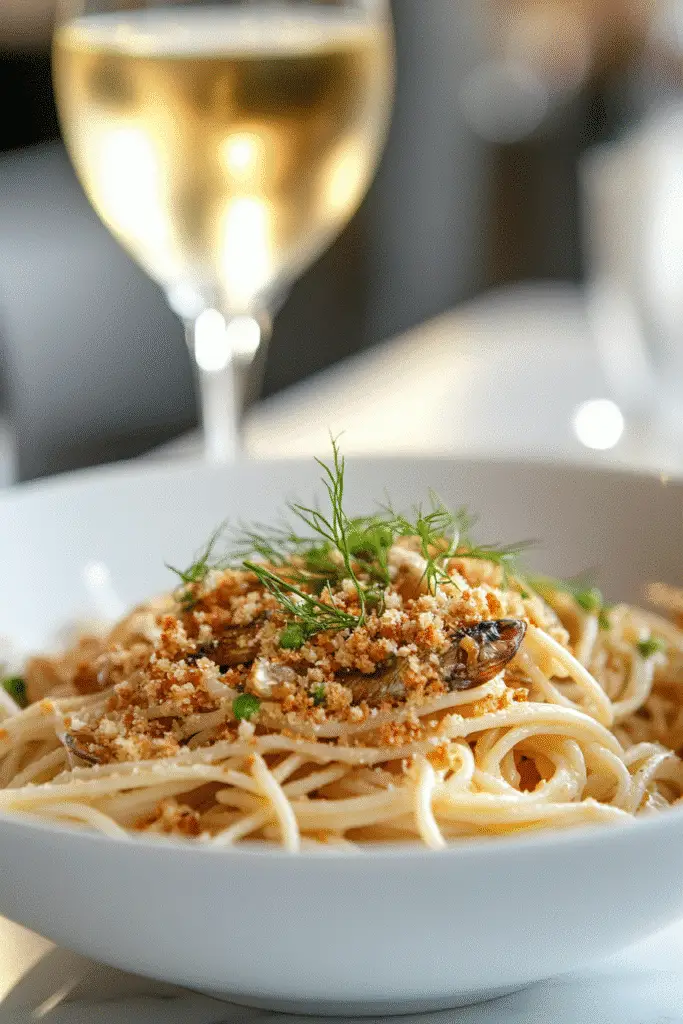
Step-by-Step Cooking: From Skillet to Plate
This is where your kitchen turns into a Sicilian trattoria. Now that you’ve prepped your sardines, breadcrumbs, fennel, and aromatics, it’s time to bring the Sicilian Sardine Pasta to life.
Here’s the full cooking process broken down:
- Boil the pasta
- Salt your water like the sea
- Use bucatini or spaghetti, cook until just al dente
- Start the sauce in a large skillet
- Heat 3 tbsp olive oil over medium
- Sauté the onion until soft
- Add anchovies, stir until they dissolve
- Add chopped sardines
- Cook just 2 minutes to avoid overcooking
- Add a pinch of salt and fresh-cracked pepper
- Incorporate the raisin-saffron mixture
- Stir in the soaked raisins and saffron liquid
- This gives color and a subtle sweetness
- Add fennel and pine nuts
- Stir in the chopped fennel and toasted pine nuts
- Let simmer gently for 8–10 minutes
- Combine with pasta
- Drain the pasta (reserve ½ cup pasta water)
- Add pasta to skillet and toss to coat
- Add pasta water a bit at a time to loosen the sauce
- Finish with muddica and olive oil
- Stir in half the toasted breadcrumbs
- Drizzle extra olive oil before serving
Don’t miss our elote pasta salad recipe for another bold pasta variation with layered flavors.
Why Pasta Water is Your Secret Weapon
You might be tempted to dump all your pasta water down the drain—but wait.
A few tablespoons of that starchy, salty liquid:
- Helps the sauce stick to the noodles
- Balances out oil-rich ingredients
- Adds smoothness without thinning flavor
Use just enough to make your sauce silky, not soupy.
Plating the Traditional Sicilian Way
Sicilian Sardine Pasta is best served in warm shallow bowls, topped with:
- Remaining crispy muddica
- A drizzle of high-quality olive oil
- Fresh fennel fronds or parsley for garnish
Pro tip: Serve immediately! This dish tastes best hot, while the breadcrumbs are still crunchy.
Health Benefits of Sicilian Sardine Pasta
A Nutrient-Dense Mediterranean Meal
Sicilian Sardine Pasta isn’t just delicious—it’s a powerhouse of health benefits. Rooted in the Mediterranean diet, this dish offers essential nutrients while remaining flavorful and satisfying.
From omega-3s to antioxidants, every ingredient plays a role in nourishing your body. It’s no wonder this pasta is a staple in Sicilian homes known for longevity and heart health.
Here’s what you’re really feeding yourself with every bite.
Sardines: Small Fish, Big Nutrition
Sardines are one of the healthiest fish you can eat. They’re:
- Rich in Omega-3 fatty acids: Good for heart, brain, and joints
- Loaded with calcium: Especially if you’re using canned sardines with bones
- High in protein: Keeps you full and supports muscle growth
- Low in mercury: Safer than larger fish like tuna
Learn more about the nutritional value of sardines on Wikipedia.
Olive Oil and Pine Nuts: Healthy Fats That Fuel You
Extra virgin olive oil is a core ingredient in Sicilian Sardine Pasta—and for good reason. It’s:
- A source of monounsaturated fat that lowers bad cholesterol
- High in polyphenols that help fight inflammation
- Great for brain and heart health
Pine nuts add a similar type of healthy fat, plus they bring in vitamin E, magnesium, and iron, supporting everything from your immune system to your metabolism.
Together, these fats create lasting energy without spiking your blood sugar.
Saffron and Fennel: Anti-Inflammatory All-Stars
Saffron isn’t just for color—it’s packed with antioxidants like crocin and safranal that may:
- Improve mood
- Reduce PMS symptoms
- Fight oxidative stress
Meanwhile, fennel (both bulb and fronds) is:
- High in fiber for digestion
- Rich in potassium for heart health
- Known for its anti-bloating effects
These herbs make the dish naturally digestive and soothing.
Breadcrumbs and Pasta: Carbs With a Purpose
While some shy away from carbs, the ones in this dish come from:
- Whole or semi-whole wheat pasta
- Fresh breadcrumbs made from real, rustic bread
These slow-digesting carbs provide:
- Stable energy
- Fiber to support digestion
- Satiety, reducing snack cravings later
Check out our fiber-rich kale pasta salad for another healthy carb option!
Why Sicilian Sardine Pasta Fits a Balanced Diet
This meal is:
- Naturally dairy-free
- Full of healthy fats and lean proteins
- Packed with plant-based elements from fennel and raisins
- Customizable for gluten-free diets with the right pasta
In one dish, you’re getting heart-healthy oils, marine-based protein, antioxidants, and gut-friendly fiber. It’s hard to beat that combo.
Explore more on the Mediterranean diet at Wikipedia.
Tips, Tricks & Regional Variations of Sicilian Sardine Pasta
How Real Sicilians Make Sardine Pasta at Home
In Sicily, every town—and sometimes every family—has its own spin on Sicilian Sardine Pasta. While the core ingredients remain consistent, it’s the small touches that make each version unique.
Here are some local secrets passed down through Sicilian kitchens:
- Use stale bread for muddica – Only day-old bread gives the breadcrumbs the right crunch and flavor
- Always soak raisins in warm saffron water – This enhances both color and aroma
- Don’t overcook the sardines – They should stay slightly soft, not flaky or dry
- Use wild fennel when in season – It’s foraged in the countryside and brings an unmistakable perfume to the dish
Discover great ideas like this from our merry-me-chicken-pasta—another recipe packed with tradition and flavor.
Palermo vs. Catania: The Subtle but Tasty Differences
In Palermo, the version of Sicilian Sardine Pasta you’re likely to find is the most traditional:
- Uses wild fennel, sardines, raisins, and pine nuts
- No cheese added—only toasted muddica
- Served especially on St. Joseph’s Day in March
In Catania, however, you might see modern twists:
- Slight use of tomatoes for a touch of acidity
- Some include a splash of white wine in the sauce
- Often served with linguine instead of bucatini
These changes might sound subtle, but they shift the dish’s balance in interesting ways.
Creative Modern Twists Without Losing the Soul
Want to make Sicilian Sardine Pasta your own without straying too far? Try these creative, yet authentic-friendly updates:
| Classic Ingredient | Modern Alternative | Why It Works |
|---|---|---|
| Wild fennel | Fennel bulb + fresh parsley | Retains aroma, easier to find |
| Bucatini | Whole wheat spaghetti | Adds more fiber, still traditional |
| Pine nuts | Toasted sunflower seeds | Cheaper but still nutty and rich |
| Fresh sardines | Canned sardines with lemon zest | Brightens the flavor and saves time |
Also, don’t be afraid to spice it up with:
- Red pepper flakes
- Lemon zest
- A dollop of ricotta on the side (optional, but creamy!)
Mistakes to Avoid When Making This Dish
To truly honor the spirit of Sicilian Sardine Pasta, watch out for these common mistakes:
- Using fine dry breadcrumbs – These won’t toast correctly and lack texture
- Skipping the saffron – It’s essential for both color and aromatic depth
- Cooking sardines too long – Overdone sardines can become metallic in flavor
- Adding grated cheese – Traditional recipes skip cheese to keep seafood pure
Stick with tradition, but feel free to put your personal stamp on it once you’ve nailed the basics.
Perfect Pairings for Sicilian Sardine Pasta
What to Drink With Sicilian Sardine Pasta
Sicilian Sardine Pasta has complex, layered flavors—salty, sweet, herbal, and earthy. So, your wine needs to balance richness while enhancing brightness.
Here are the best wine pairings:
- Grillo (Sicilian White Wine): Crisp and citrusy, balances the anchovy and sardine umami
- Vermentino: Light-bodied, floral, perfect with saffron
- Dry Rosé: Slight acidity that cuts through the olive oil richness
- Frappato (if you love red): A light Sicilian red that won’t overpower the fish
Want a non-alcoholic option? Try a chilled sparkling lemonade with fresh mint—it echoes the herbal and citrusy notes of the dish.
Side Dishes That Complement Without Competing
Sicilian Sardine Pasta is the star, so your sides should be light, fresh, and minimal.
Here are our top pairing ideas:
| Side Dish | Why It Works |
|---|---|
| Arugula & lemon salad | Peppery, acidic contrast to the sweet raisins |
| Grilled eggplant with garlic oil | Earthy, simple, Sicilian favorite |
| Sliced orange salad with olives | Bright, refreshing, a perfect palate cleanser |
| Fennel and blood orange salad | Doubles down on the fennel, but adds juicy brightness |
| Toasted sourdough with olive oil | A simple vehicle for any leftover muddica or sardine bits |
These side options keep your meal grounded in Mediterranean traditions without overwhelming the main attraction.
Seasonal Touches to Elevate the Dish
Depending on the time of year, adding a seasonal element can make this dish feel extra special. Here’s how Sicilians do it:
- Spring: Use fresh wild fennel if available
- Summer: Garnish with lemon zest and mint
- Fall: Swap raisins with dried figs or golden sultanas for depth
- Winter: Add a pinch of chili flakes to warm things up
These are minor tweaks, but they can subtly transform your Sicilian Sardine Pasta into a more memorable and seasonally aligned dish.
Don’t miss our vibrant blog archive for more Mediterranean pairing inspiration and seasonal dishes!
Make-Ahead Tips & Storage for Sicilian Sardine Pasta
Can You Make Sicilian Sardine Pasta Ahead of Time?
Absolutely—but with a few adjustments.
Sicilian Sardine Pasta is best served fresh, but if you’re planning a dinner party or want leftovers for the next day, here’s how to prep ahead without sacrificing flavor or texture:
- Make the sauce a day ahead – Store it in an airtight container in the fridge. Reheat gently in a skillet, not a microwave.
- Toast breadcrumbs the same day – They lose crunch if stored too long.
- Cook pasta fresh – Always. Pasta should never sit overnight with sauce or it will absorb too much and turn gummy.
Best Practices for Storing Leftovers
Have leftovers? No problem. Here’s the best way to store and revive them:
| Storage Method | Instructions |
|---|---|
| Refrigeration | Place pasta in an airtight container for up to 2 days |
| Freezing | Not recommended – sardines and breadcrumbs lose texture |
| Reheating | Reheat in a skillet with olive oil or splash of pasta water |
Avoid using the microwave if you can. It makes the sardines rubbery and the breadcrumbs soggy. Instead, use a non-stick skillet over low heat and stir constantly until warmed through.
Looking for inspiration for other make-ahead pasta ideas? Try our creamy pasta salad recipe that also holds up well in the fridge.
How to Keep Breadcrumbs Crispy After Storing
If you’ve already mixed breadcrumbs into the pasta, they’ll soften over time. Here’s what you can do:
- Re-toast them in a dry pan for a minute or two before serving again
- Or make a fresh batch if you want that just-fried crunch
Pro tip: Store extra breadcrumbs in a small jar in your freezer so they’re always ready for your next pasta moment.
Make It Work for Meal Prep
While it’s not the most meal-prep-friendly dish, you can break it into steps:
- Day 1: Clean the sardines, toast pine nuts and breadcrumbs
- Day 2: Cook the sauce and boil the pasta
- Serve: Combine and enjoy fresh
Meal prep doesn’t have to mean sacrificing quality. With Sicilian Sardine Pasta, a little planning delivers maximum flavor—without the stress.
Follow me on pinterest for more recipes
Frequently Asked Questions About Sicilian Sardine Pasta
Can I use canned sardines instead of fresh in Sicilian Sardine Pasta?
Yes, you absolutely can. In fact, canned sardines in olive oil are a smart and convenient alternative when fresh ones aren’t available.
While fresh sardines deliver a more delicate, tender bite and richer seafood aroma, canned sardines provide:
- Great flavor
- Excellent shelf stability
- Easier prep (no cleaning needed)
To adapt: simply drain the oil (or use it to sauté your onions), break the sardines into chunks, and gently fold them into the sauce toward the end. This keeps their texture intact and prevents them from becoming overly soft.
What is the origin of Sicilian Sardine Pasta?
Sicilian Sardine Pasta, or Pasta con le Sarde, originated in Palermo, Sicily, and dates back over a thousand years. Historians believe it was created during the Arab occupation of Sicily in the 9th century.
The dish is a perfect example of Arab-Sicilian fusion, combining:
- Sweet raisins
- Earthy saffron
- Wild herbs (like fennel)
- Savory sardines
It was traditionally eaten during St. Joseph’s Day, symbolizing resourceful, humble cooking. Today, it’s a year-round staple in Sicilian homes.
Is Sicilian Sardine Pasta healthy?
Definitely. Sicilian Sardine Pasta checks all the boxes of a Mediterranean superfood dish. It’s packed with:
- Omega-3 fatty acids from sardines
- Antioxidants from saffron and olive oil
- Fiber from fennel and golden raisins
- Lean protein and healthy fats
Plus, it’s naturally dairy-free and can easily be made gluten-free with alternative pasta. When made with fresh ingredients and the right olive oil, it supports heart, brain, and digestive health.
Check out our kale pasta salad for another Mediterranean-style dish with powerful health benefits.
Can I freeze Sicilian Sardine Pasta?
It’s not recommended.
Freezing Sicilian Sardine Pasta can lead to:
- Dry, rubbery sardines
- Soggy breadcrumbs
- Clumpy pasta
Instead, store in the fridge for up to 2 days in an airtight container. Reheat gently in a skillet with olive oil or a splash of pasta water. If you want to save time, prepare components separately and assemble fresh.
Why You Should Try Sicilian Sardine Pasta Today
If you’ve made it this far, there’s no doubt: Sicilian Sardine Pasta isn’t just another weeknight recipe—it’s a story. It’s a bite of tradition, passed down through generations, rich with Mediterranean flavors, and layered with love, texture, and culture.
Whether you use canned sardines or fresh catch, muddica or breadcrumbs, wild fennel or its everyday cousin—this dish is all about bringing something soulful to your table.
Don’t wait for a special occasion. The time to eat like a Sicilian is right now.
Don’t miss our flavorful archive of pasta recipes like the dill pickle pasta salad recipe and more on our blog.


